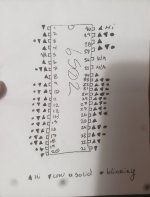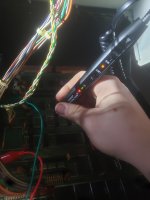Hugo Holden
Veteran Member
I agree with the logic probe suggestion.
If you have not owned a scope before, a very good place to start is with an analog scope. Not so vintage that it is unreliable and needs repairs though.
Hitachi made a very good range of reliable scopes, the compact ones are the V509, V209, but other models like the V212 turn up, often well cared for probable one owner types from estate sales, one typical example:

These sorts of scopes are intuitive, dead easy to use. Once you have mastered it in a few years you can move to digital scopes which can be a little more tricky to set up correctly, but have lots of additional features.
Once you start to use a scope, and can see into the dynamics of the circuits you are working with, building or repairing, whatever those circuits are, analog, digital etc, you will wonder how on Earth you ever managed without one, because it is a whole new world of understanding and insight.
If you have not owned a scope before, a very good place to start is with an analog scope. Not so vintage that it is unreliable and needs repairs though.
Hitachi made a very good range of reliable scopes, the compact ones are the V509, V209, but other models like the V212 turn up, often well cared for probable one owner types from estate sales, one typical example:

Hitachi V-212 Analog Oscilloscope 20MHz 2-Channel. | eBay
Find many great new & used options and get the best deals for Hitachi V-212 Analog Oscilloscope 20MHz 2-Channel. at the best online prices at eBay! Free shipping for many products!
www.ebay.com
These sorts of scopes are intuitive, dead easy to use. Once you have mastered it in a few years you can move to digital scopes which can be a little more tricky to set up correctly, but have lots of additional features.
Once you start to use a scope, and can see into the dynamics of the circuits you are working with, building or repairing, whatever those circuits are, analog, digital etc, you will wonder how on Earth you ever managed without one, because it is a whole new world of understanding and insight.





